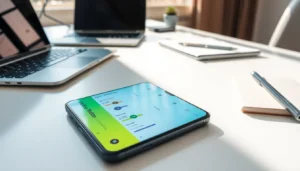In a world where screens dominate our lives, finding a way to cut back can feel like trying to escape a digital prison. If you’ve ever stared at your phone, wishing you could break free from the chains of screen time restrictions—especially when you don’t have the password—you’re not alone. It’s like being on a diet while your fridge is stocked with cake. Tempting, right?
Table of Contents
ToggleUnderstanding Screen Time Management
Screen time management plays a crucial role in achieving a balanced digital lifestyle. Recognizing its impact can motivate individuals to implement effective strategies.
The Importance of Screen Time
Understanding the importance of screen time is essential for maintaining overall well-being. Excessive screen use can lead to physical health issues, such as eye strain and poor posture. Mental health also suffers, with increased risks of anxiety and depression linked to overuse. Limiting screen time fosters better sleep quality and encourages more engaging, real-world activities. This balance promotes healthy relationships and enhances productivity in personal and professional contexts.
Common Features of Screen Time
Common features of screen time management include tracking and limiting device usage. Most operating systems offer built-in tools to monitor usage patterns, providing insight into daily habits. Users can set specific time limits for apps or functions to regulate access effectively. Additionally, alerts remind users when they exceed their set limits. Parental controls also serve as a valuable feature, allowing parents to restrict their children’s access to certain applications or content. These features collectively empower users to manage their screen time more efficiently.
Methods to Bypass Screen Time
Several options exist for bypassing screen time restrictions, which can be useful for users seeking control over their device usage.
Using Device Settings
Users can access device settings to manage screen time limits effectively. First, one can navigate to the settings on their mobile device. Locate the “Screen Time” or “Digital Wellbeing” section. Adjustments to app limits may provide the necessary flexibility. An option to disable restrictions often appears, allowing for a temporary reprieve. Individuals may also reset the device settings; doing so may restore original access but requires adherence to prior rules.
Third-Party Tools and Apps
Various third-party tools and apps assist in managing screen time without passwords. Many of these options offer features tailored to individual preferences. For instance, applications like “Freedom” or “Stay Focused” enable users to block specific apps or websites. These tools allow customization, ensuring maximum effectiveness for users. Some apps even track usage patterns, providing insights into habits, which can help users become more aware of their screen time. Employing these resources often leads to better management of digital device engagement.
Risks and Considerations
Bypassing screen time restrictions can lead to various risks and considerations. Users should evaluate the potential impacts before making changes to their device settings or utilizing third-party tools.
Potential Drawbacks of Bypassing Restrictions
Disabling restrictions often reduces accountability in managing screen time. Users may find themselves increasing usage significantly without realizing it. This can lead to deteriorating social interactions as more time spent on devices replaces face-to-face communication. Additionally, excessive screen time may worsen physical health conditions like eye strain and disrupt sleep patterns. Engaging with digital content late at night can hinder sleep, impacting mood and cognitive performance the next day. Ultimately, the initial intent of reducing screen time can ironically backfire when restrictions are ignored.
Ethical Implications
Bypassing screen time restrictions raises ethical questions surrounding personal responsibility. Users must consider the implications of choice and the impact on mental and physical health. Manipulating device settings to enable excessive screen time can set a poor example for children and others in the household. Adults may overlook the importance of fostering healthy digital habits in their families. The desire for unrestricted use clashes with the idea of responsible technology usage. Encouraging self-discipline and balance contributes to a healthier relationship with screens.
Tips for Healthy Screen Time Habits
Managing screen time involves conscious choices and healthy habits. Implementing these strategies fosters a balanced approach to technology use.
Setting Personal Limits
Establishing personal limits helps control screen time effectively. Begin by assessing daily device usage and identifying problem areas. Create specific timeframes for device use, such as limiting social media to 30 minutes per day. Use built-in features on devices to set reminders or automatic lockout periods. Personal accountability increases when users track usage patterns, making it easier to recognize behavior changes. Regularly reviewing these limits ensures they remain relevant and effective, aligning with lifestyle adjustments or changes in priorities.
Engaging in Alternative Activities
Finding alternative activities encourages less dependence on screens. Exploring hobbies like reading, painting, or gardening offers fulfilling experiences without digital engagement. Socializing in person strengthens relationships and enhances social skills. Participating in physical activities, such as jogging or joining a sports team, promotes a healthier lifestyle. Scheduling regular outings with friends and family diverts attention from screens. Discovering new interests fosters personal growth and satisfaction, highlighting the benefits of a balanced life beyond digital devices.
Reducing screen time without a password is achievable through mindful strategies and personal accountability. By taking control of device usage and setting clear limits individuals can cultivate healthier habits that promote overall well-being.
Engaging in real-world activities and exploring new interests not only enhances social interactions but also contributes to personal growth. Balancing digital engagement with offline pursuits leads to improved mental and physical health.
Ultimately fostering a responsible relationship with technology empowers individuals to enjoy the benefits of their devices while minimizing the risks associated with excessive screen time. Embracing these practices can lead to a more fulfilling and balanced lifestyle.

